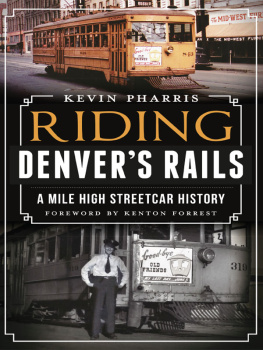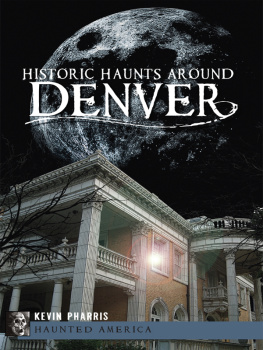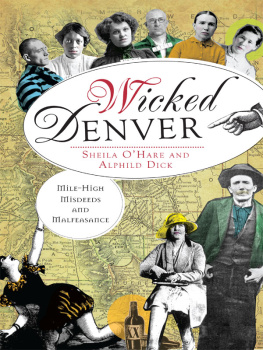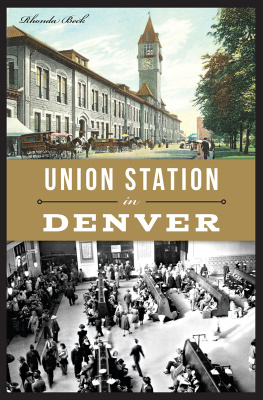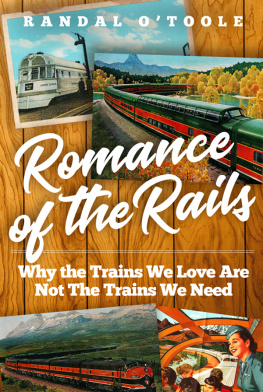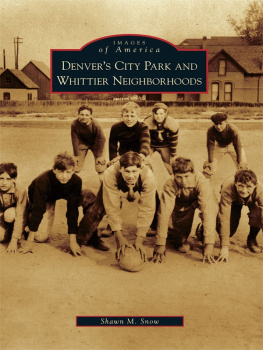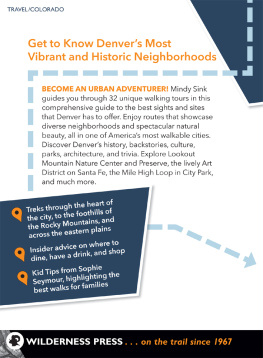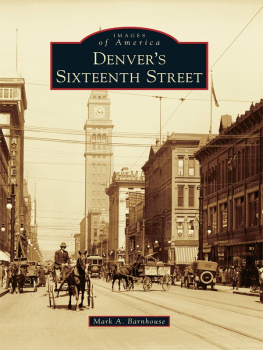

Published by The History Press
Charleston, SC 29403
www.historypress.net
Copyright 2013 by Kevin Pharris
All rights reserved
Front Cover: Though the anthropomorphized streetcar on the sign was crying, the driver was all smiles as he made his last runs using the rails. Perhaps he, as with many Denver commuters, was looking forward to the shining era promised by buses. RTD.
First published 2013
e-book edition 2013
Manufactured in the United States
ISBN 978.1.61423.895.9
Library of Congress CIP data applied for.
print edition ISBN 978.1.60949.915.0
Notice: The information in this book is true and complete to the best of our knowledge. It is offered without guarantee on the part of the author or The History Press. The author and The History Press disclaim all liability in connection with the use of this book.
All rights reserved. No part of this book may be reproduced or transmitted in any form whatsoever without prior written permission from the publisher except in the case of brief quotations embodied in critical articles and reviews.
CONTENTS
FOREWORD
My family left Minnesota in 1955 for Denver, a city that had been entirely shaped by the streetcar and its predecessors. All the same, by the time we arrived, almost all of it was gone. Tracks were being paved over, the overhead wires were being taken down and the streetcars and trolley coaches that had once connected to those wires were being dismantled and discarded. To be certain, there were transit vehicles still on the streets, but a story stretching back more than eighty years had ended. Denver was moving resolutely into the future.
The diesel-powered buses rolling along Denvers streets still fascinated me, and once I began examining more closely, I realized that they connected to a lost world of transit. I was captivated, and a passion for Denvers transit began, growing throughout my entire life, a passion that has fueled almost every non-working moment. How did the trolley cars get from one end of the line to the other? Why did the routes change, and how? Who were the people, and what were their stories? The tramway is getting further and further away from us now, but it remains a very real element of the present for those of who have made its study our lifes work.
This book is not meant to be the definitive, all-inclusive source on Denvers transit history. Those books have already been written as the three-volume work known as Denvers Street Railways, a portion of which I wrote and edited. Rather, this book is intended to introduce a new generation of Denverites to something that, even today, is dramatically affecting our city.
The first chapter provides a brief overview, drawn from numerous sources, of the regions rich transit history. Denver is not the only city in the United States that expanded because of transit, but we cannot study them all in one short book. Through extrapolation, and allowing for some local variations, we may understand the general course of transit in the United States from the earliest omnibuses to the modern fleet of buses ubiquitous in many urban American cities.
Streetcars last worked the rails of Denver in 1950, so more than sixty years divide us from their era. The ever-increasing amount of time is steadily robbing us of the voices who can speak to us about the experience of riding the streetcar. I have had the honor to work with some of the great figures in transit history and have experienced the grief of seeing us lose these invaluable founts of information. The personal recollections of members of the general public have no less impact, however, and these voices are also being lost. The second chapter of this book focuses on their stories and impressions, lending an individual connection undimmed by the numerous decades. The author has asked to include my own story, and it is contained there as well.
examines the modern day and the return of multi-modal transit to Denver and the region. I am glad Denver is moving ahead with these projects, because those of us who call the city home will be well-served by the sound planning and decisions that are now building infrastructure for the future. It will not be built in a day, but neither were the original streetcar lines and the cities they served.
It is vital that we continue studying the history of transit in Denver, keep reading about it and keep writing about it. In doing so, we will all come to understand that we are not creating something new on the ashes of everything that came before us. We are continuing their inspired work, and what a ride it will be. All aboard!
Kenton Forrest
ACKNOWLEDGEMENTS
This book is dedicated to Shawn Snow. His passion for history in general and transit in specific enriches us all!
This book would not have been possible without the generosity of those who shared their memories, pictures, information and time, especially Kenton Forrest, the folks at the Colorado Railroad Museum, the Denver Tramway Heritage Society and the Regional Transportation District. Thank you!
Many pictures in this volume may be attributed to the following: the Denver Municipal Facts (DMF); the Denver Tramway Heritage Society (DTHS); the Colorado Railroad Museum (CRM); the Regional Transportation District (RTD); and the Englewood Public Library (EPL). Those not otherwise accredited are in the authors personal collection.
CHAPTER 1
THE TICKET TO THE FUTURE
Denver once had an extensive system of electrically powered transit, composed of more than 250 miles of track within the Denver metropolitan area and 40 miles of high-speed interurban rail, connecting the city with Golden and Boulder. For work, shopping, school and entertainment, Denvers streetcars were a fully integrated part of daily life. Despite this, all streetcar service was abandoned in 1950. In the first chapter of Riding Denvers Rails, we examine the history, in Denver and otherwise, that led to the streetcars meteoric rise and equally dramatic fall, all within less than a full century.
Even as this book is being written, transit is being hotly discussed in and around Denver. One of the discussions focuses on a new campaign put out by the Denver Regional Council of Governments (known as DRCOG), which includes billboards, advertisements on the sides of buses and Light Rail trains, as well as radio promotions and an explanatory website. The website lists ways to avoid being an SOV, which is a transit acronym for single occupancy vehicle. According to the website, one may carpool, vanpool, bike, work from home, use park and rides (to get to work via bus or train) or walk. The intention is to decrease the number of trips with a single person in the carabout 75 percent of all outings in the metropolitan area. As the city continues to growand in anticipation of putting more cars on the roadthe proposal makes sense.
Owing to the perhaps not-so-accidental similarity the acronym has to a more offensive one, the advertising campaign has garnered some criticism. Bob Whitson, executive director of Boulder Transportation Connections, agreed with the goal of getting more people to explore transit options but felt the campaign was negative and anti-car. The Denver Post called the ads cheeky. The communications and marketing director at DRCOG, Steve Erickson, countered that the ads were meant to be playful.

Next page
